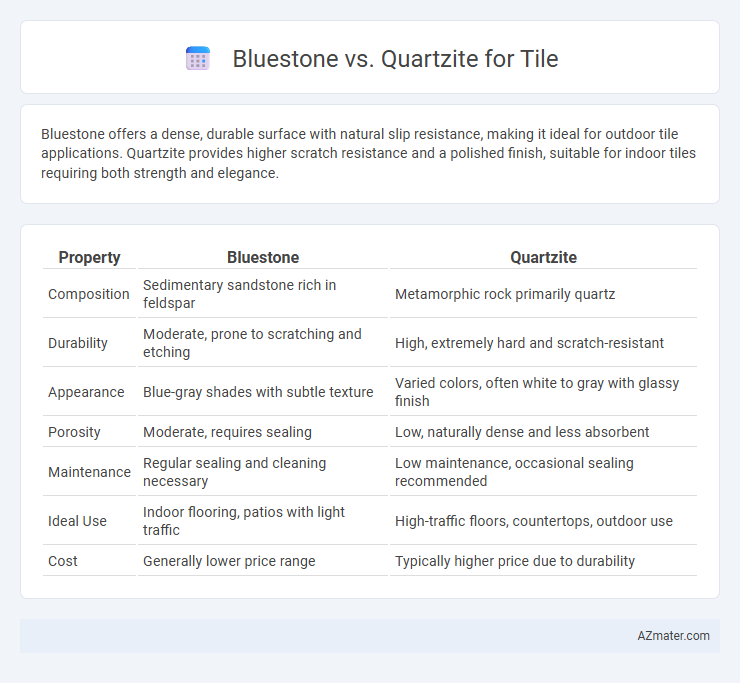Bluestone offers a dense, durable surface with natural slip resistance, making it ideal for outdoor tile applications. Quartzite provides higher scratch resistance and a polished finish, suitable for indoor tiles requiring both strength and elegance.
Table of Comparison
| Property | Bluestone | Quartzite |
|---|---|---|
| Composition | Sedimentary sandstone rich in feldspar | Metamorphic rock primarily quartz |
| Durability | Moderate, prone to scratching and etching | High, extremely hard and scratch-resistant |
| Appearance | Blue-gray shades with subtle texture | Varied colors, often white to gray with glassy finish |
| Porosity | Moderate, requires sealing | Low, naturally dense and less absorbent |
| Maintenance | Regular sealing and cleaning necessary | Low maintenance, occasional sealing recommended |
| Ideal Use | Indoor flooring, patios with light traffic | High-traffic floors, countertops, outdoor use |
| Cost | Generally lower price range | Typically higher price due to durability |
Introduction: Bluestone vs Quartzite for Tile
Bluestone and quartzite are popular choices for tile due to their durability and aesthetic appeal in flooring and wall applications. Bluestone, a dense sandstone, offers a natural, earthy look with a textured surface that enhances slip resistance. Quartzite, a metamorphic rock, provides exceptional hardness and a glassy finish, making it ideal for high-traffic areas requiring both strength and elegance.
Overview of Bluestone Tile
Bluestone tile, a dense, fine-grained sandstone composed primarily of feldspar and quartz, is prized for its natural slip resistance and durability in both indoor and outdoor applications. Its muted blue-gray hues with occasional rust and green tones offer a versatile aesthetic suitable for patios, walkways, and pool surrounds. Bluestone's resistance to weathering and ability to maintain structural integrity under heavy foot traffic make it a preferred choice for high-traffic tile installations.
Overview of Quartzite Tile
Quartzite tile, a natural stone formed from quartz-rich sandstone under high heat and pressure, offers exceptional hardness and durability ideal for high-traffic areas. Its dense structure makes it highly resistant to scratches, heat, and stains, ensuring longevity in both indoor and outdoor applications. Quartzite tiles showcase a unique, glassy finish with subtle veining and a color palette ranging from white and gray to pink and red, providing a sophisticated aesthetic for flooring and wall installations.
Appearance and Color Options
Bluestone offers a natural, earthy palette with shades ranging from deep blues and grays to rich browns, creating a rustic yet elegant appearance ideal for outdoor and indoor tile applications. Quartzite provides a more varied color spectrum, including whites, pinks, and soft grays, with a subtle crystalline texture that enhances brightness and adds a sophisticated, polished look to tile surfaces. Selecting between Bluestone and Quartzite depends on desired aesthetic effects, with Bluestone emphasizing rugged natural beauty and Quartzite delivering refined, vibrant color options.
Durability and Hardness Comparison
Bluestone offers moderate durability with a Mohs hardness rating of 3 to 4, making it more prone to scratches and wear in high-traffic areas. Quartzite is significantly harder, boasting a Mohs hardness of 7, which provides superior resistance to scratching and chipping, ideal for tile applications requiring long-term durability. The dense crystalline structure of quartzite also enhances its strength and longevity compared to the softer, more porous composition of bluestone.
Water Resistance and Porosity
Bluestone exhibits moderate water resistance with a porosity level typically ranging from 4% to 8%, making it susceptible to water absorption and staining if not sealed properly. Quartzite features lower porosity, often below 1%, providing superior water resistance and durability, ideal for wet areas and high-traffic tiles. Proper sealing enhances the longevity and performance of both materials, but quartzite generally outperforms bluestone in resisting moisture and preventing damage.
Maintenance Requirements
Bluestone tile requires regular sealing to prevent staining and water absorption due to its porous nature, along with routine sweeping and mopping to maintain its appearance. Quartzite tiles, being denser and harder, need less frequent sealing and are more resistant to scratches and stains, making maintenance easier over time. Both materials benefit from using pH-neutral cleaners to preserve their surface integrity and prolong tile lifespan.
Cost Differences and Value
Bluestone typically costs between $5 and $10 per square foot, making it a more budget-friendly option compared to quartzite, which ranges from $7 to $15 per square foot due to its natural durability and unique veining. Quartzite offers higher value for tile installations with superior hardness and resistance to scratches and stains, ensuring longevity in high-traffic areas. Choosing between bluestone and quartzite depends on balancing upfront cost savings with long-term durability and maintenance investment.
Ideal Applications: Indoor and Outdoor
Bluestone offers exceptional durability and natural slip resistance, making it ideal for outdoor applications such as patios, walkways, and pool surrounds, while its rich colors enhance indoor spaces like entryways and fireplaces. Quartzite, known for its hardness and resistance to scratching and heat, excels in high-traffic indoor areas including kitchens, bathrooms, and countertops, as well as exterior facades and outdoor flooring exposed to harsh weather. Both stones provide versatile solutions, but bluestone is preferred for textured outdoor settings, while quartzite suits sleek, polished indoor environments requiring robust wear resistance.
Choosing the Right Stone for Your Project
Bluestone offers a dense, fine-grained texture ideal for outdoor patios and pool decks due to its slip-resistant surface and natural durability. Quartzite, a metamorphic rock formed from sandstone, provides superior hardness and a polished finish, making it suitable for high-traffic indoor flooring and decorative wall tiles. Selecting between bluestone and quartzite depends on project requirements like weather exposure, foot traffic, and aesthetic preferences, ensuring optimal longevity and visual appeal.

Infographic: Bluestone vs Quartzite for Tile
 azmater.com
azmater.com